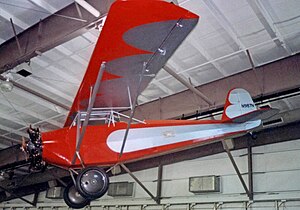Texas-Temple Sportsman
| Texas-Temple Sportsman | |
|---|---|

| |
| The sole surviving Sportsman monoplane on display at the Frontiers of Flight Museum at Dallas, Texas | |
| Role | sporting monoplane |
| National origin | United States |
| Manufacturer | Texas Aero Corporation |
| Designer | George W Williams and George Carroll |
| First flight | 1928 |
| Status | one example preserved |
| Primary user | private pilot owners |
| Produced | 1928 |
| Number built | 3 |
The Texas-Temple Sportsman is an American-built light single-seat high-wing sporting monoplane of the late 1920s.
Design and development[edit]
The Texas Aero Corporation of Temple, Texas was formed about 1927 to construct passenger and mail light aircraft. The companies origin can be traced back to George W Williams Texas Aero Manufacturing Company of 1911. It built a series of aircraft designs including the Texas-Temple Sportsman.[1]
The Sportsman was a parasol winged monoplane, equipped with two seats arranged in tandem. The cockpit had an open layout. A fixed tail-wheel undercarriage was fitted. The tailplane was set low on the fin. A 100 h.p. Cirrus III was initially fitted.[1]
Operational history[edit]
Three examples of the Sportsman were completed: NC480 manufacturers number 1; NC852H and N987N manufacturers number 107. There was no N987N registered in FAA records at the time, so it is likely to be from a later registration. There was an NC987H, but that was the registration for a different make of aircraft, a Smith S-1 with a Velie engine.[1][2] The Sportsman was suitable for operation by individual sporting pilots. Williams was killed during 1930 in the crash while flying with a trainee pilot. The company folded after the accident.[1]
Surviving aircraft[edit]

The third Sportsman survived the Second World War and was rebuilt in 1990 by J.D. Ferrel with a radial engine of unknown manufacture. It is still extant, but without a valid permit to fly.[3] N987N is publicly displayed (2007) in the Frontiers of Flight Museum at Dallas (Love Field) airport.[4]
Specifications[edit]
Not available. The aircraft was originally fitted with a 100 h.p. ADC Cirrus III engine.[1] General characteristics Performance
References[edit]
Notes[edit]
- ^ a b c d e "American airplanes - Wh - Wy". www.aerofiles.com. 1 May 2009. Retrieved 5 December 2010.
- ^ "Civil Aircraft Register - United States". Archived from the original on 2012-06-29. Retrieved 2012-09-28.
- ^ "FAA Registry - N987N". 4 December 2010. Retrieved 5 December 2010.
- ^ Ogden, P. 499
Bibliography[edit]
- Ogden, Bob (2007). Aviation Museums and Collections of North America. Air-Britain (Historians) Ltd. ISBN 978-0-85130-385-7.
